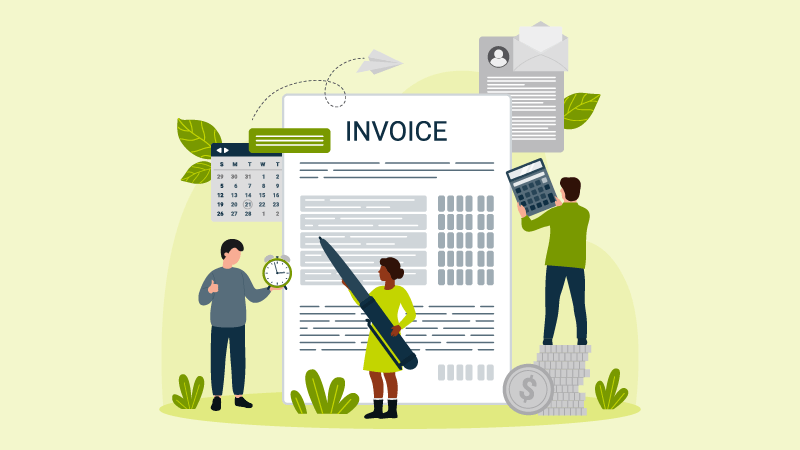
Accounts payable (AP) teams are under immense pressure to process invoices faster and reduce operational costs. Despite significant technological advancements, many AP teams are still struggling with manual intervention throughout the invoice lifecycle – a challenge that undermines efficiency and makes achieving the aforementioned goals impossible.
A report by Ardent Partners states that it takes roughly 10 days and over nine dollars to process a single invoice manually. According to the same report, innovative processes that incorporate accounts payable automation result in 80% lower invoice processing costs and 73% faster cycle times.
But how can your AP team reduce manual intervention in invoice processing, so you can realize these benefits and more?
This blog post examines why manual invoice processing persists and provides the top strategies for eliminating manual touchpoints.
Why Invoice Processing Remains Labor-Intensive
In order to effectively automate invoice processing, you need to understand why it’s so often labor-intensive in the first place – even when technology is leveraged. Here are some root causes:
Disparate Systems with Poor Integration
Many AP teams use multiple invoice processing tools that don’t communicate effectively, forcing staff members to manually transfer data between systems. This slows down processing times, increases errors due to inconsistent data, and makes clear visibility into cash flow and spending unattainable.
Inconsistent Invoice Formats
Suppliers submit invoices in various formats, including PDFs, email attachments, paper files, and electronic data interchange, making standardization and automation difficult. AP teams spend valuable time manually normalizing data, which delays invoice approvals, opens the door to data latency, and dramatically increases the likelihood of miskeyed information.
Not to mention, incoming paper invoices lead to inefficiencies, higher costs, and a greater risk of lost or duplicate invoices since they require manual retrieval, digitization, and data entry. And many organizations lack the technology to automatically extract the data from emailed invoices.
Undefined Approval Workflows
Without predefined routing rules, invoices get trapped in approval purgatory, requiring manual intervention and leading to delays. Delayed invoice approvals can then result in late payments, strained supplier relationships, and missed early payment discounts.
Complex Exception Handling
A recent study found that 45% of AP departments believe exception management is a top challenge preventing them from achieving better results.
Data mismatches, missing purchase order numbers, and discrepancies often require AP teams to step in and resolve issues. Manual invoice exception handling increases processing costs and slows down invoice cycles, making AP a reactive function.
Without a fundamental shift in approach, AP teams will remain trapped in a cycle of inefficiency – bogged down by tedious, manual tasks, rising costs, delayed approvals, and frustrated suppliers.
Limitations of Traditional Invoice Processing Automation Approaches
Many teams invest in and count on invoice processing automation to ease the labor-intensity of accounts payable, but they’re often unfamiliar with the varying levels of AP automation and, in turn, make the mistake of relying on traditional options. Conventional approaches often fail to eliminate manual intervention due to several key limitations, including:
Overreliance on OCR for Data Capture
Optical character recognition (OCR) technology presents several invoice processing limitations that make manual intervention a necessity. Teams that leverage OCR-based AP automation systems are forced to spend time searching, downloading, and uploading invoices.
Such systems are also incapable of sufficiently handling various invoice formats without extensive, manual template creation. Not to mention, OCR has a high failure rate in extracting data from emails and attachments, often misreading key invoice details and, ultimately, requiring manual corrections.
Inadequate Exception Handling Capabilities
Many conventional AP automation tools lack intelligent tools for exception resolution, meaning that when discrepancies arise, invoices must be manually reviewed and corrected. This increases workload for AP teams, slows down processing times, and results in frequent back-and-forth with suppliers.
Fragmented Invoice Approval Workflows
Traditional invoice processing automation systems frequently lack a centralized platform for managing approvals, leading to disconnected workflows. The results? Invoices lost in email chains and costly delays that ripple throughout the financial ecosystem – impacting everything from cash management to supplier relationships.
After all, slow approvals result in late payments, missed early payment discounts, unnecessary supplier inquiries, inaccurate cash forecasting, and supply chain issues.
Limited Line-Item Matching Capabilities
Older AP systems fail to achieve accurate line-item matching between invoices, purchase orders, and receipts without manual validation by AP teams. This adds time-consuming manual work and increases the risk of processing errors.
As a result, discrepancies go unnoticed until late in the process. The leads to costly delays, disputes, and payment inaccuracies – all of which could have been prevented with automated matching.
Lack of Real-Time Supplier Collaboration Tools
Many conventional AP systems do not offer effective supplier self-service portals. AP teams are left to handle high volumes of invoice and payment status inquiries – wasting time and straining supplier relationships.
To overcome these challenges, organizations must take a modern approach to invoice processing automation that uses intelligent technology to eliminate manual intervention at every stage of the invoice lifecycle.
5 Strategies to Reduce Manual Intervention in Invoice Processing
Manual intervention in invoice processing is a costly roadblock that significantly slows down operations, increases errors, and frustrates both AP teams and suppliers.
Fortunately, there are methods for breaking free from outdated processes and achieving a more efficient and touch-free workflow. Here are the top five:
Prevent Invoice Exceptions & Errors Through Proactive Management
A recent report revealed that invoice exceptions are considered one of the biggest obstacles standing in AP teams’ way of enhancing productivity, lowering processing costs, and shortening approval times. It’s not a shock that they’re also one of the biggest reasons AP teams must intervene manually.
One way your team can reduce exceptions is by standardizing supplier invoice submission requirements. Start by setting clear expectations for suppliers regarding required invoice fields, formatting, and submission methods.
You can also prevent exceptions by encouraging the use of electronic invoicing formats. Moving suppliers away from paper and PDFs to structured formats like XML or EDI improves data accuracy and processing speed. Electronic invoice formats reduce data entry, minimize processing errors, and accelerate approvals.
Implement IDP to Improve Data Capture Accuracy
Moving beyond basic OCR to intelligent document processing (IDP) technology can substantially enhance data capture accuracy and eliminate manual intervention as a result.
Invoice processing automation solutions that leverage AI-powered IDP technology improve data quality at the point of ingestion with automatic error detection functionality. These advanced solutions prevent processing errors and time wasted fixing downstream issues by ensuring that invoice data is clean, complete, and validated before entering the system.
Additionally, connecting these solutions with your ERP is a simple endeavor, eliminating the need for manual data entry, reducing the possibility of errors, improving financial visibility, and ensuring consistency between systems all at once. To ensure seamless data exchange, look for invoice processing automation systems with pre-built ERP connectors.
Optimize Approvals with Dynamic Workflow Automation
Minimizing manual work during the approval process is key. The best automation solutions ensure invoices are routed to the correct approver based on pre-set business rules.
Systematically routing invoices prevents them from getting lost or delayed due to human error. Leading automated invoice processing solutions include configurable, AI workflow automation with hierarchical approvals and automatic alerts, notifications, and escalation.
Leverage Self-Service Tools to Strengthen Supplier Collaboration
Giving suppliers real-time access to invoice and payment statuses through a self-service portal reduces inquiries – and the manual work that accompanies them – while also expediting issue resolution. Empowering suppliers frees up AP teams by minimizing calls and emails about where things stand in the process.
To truly empower suppliers, make sure clear invoice submission guidelines are established, exception causes are effectively communicated, and your portal provides historical invoice details.
Achieve End-to-End AP Process Automation
AP departments will never achieve touch-free invoice processing by taking a piecemeal approach to automation. A seamless invoice-to-pay solution – one that automates the process from invoice receipt through reconciliation – reduces handoffs.
The key is to find a single invoice processing automation platform that handles every step of the cycle and provides reporting and analytics, advanced security tools, and tracking capabilities.
By implementing these strategies and selecting the right solution, your accounts payable team can eliminate manual intervention and transform your operation into a more efficient, cost-effective, and strategic function.
Get Started with Invoice Processing Automation Today
The longer AP teams wait to eliminate manual intervention, the more inefficiencies, costs, and risks pile up. Delayed approvals, lost invoices, and error-prone data entry aren’t just frustrating – they’re holding your organization back.
The good news? The right automation solution can change everything.
MetaSource’s AI-powered invoice processing solution, SourceAP™, is purpose-built for complex PO matching and can streamline invoice processing, strengthen financial controls, and give your staff back time to focus on high-value work.
Ready to start eliminating manual work from your AP process? Schedule a SourceAP demo today.
Not quite ready to talk to an invoice processing expert? Check out our eBook on the top signs it’s time to upgrade your AP process to learn more about streamlining your operations.

